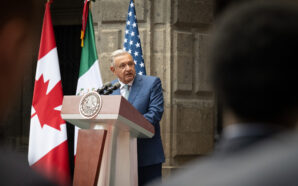Jenny Manrique; Translation by Arturo Hilario
Ethnic Media Services
When Jovanna López realized that the food received by immigrants, blacks, and indigenous people who stood in long queues at food banks in San Antonio, Texas, was out of date or rotten, she set out to work so that these communities could access fresh fruits and vegetables. Even more so when organic markets were dominated by producers who only targeted a bourgeois public with astronomical prices’ and who also rejected food stamps as payment.
So, in 2015, this food promoter co-founded People ‘s Nite Market, a night market where access to nutritious food replaced spoiled avocados and salads that were handed out in food donations. “The situation before COVID-19 was already difficult,” Lopez said during a press conference organized by Ethnic Media Services. “But when the pandemic started, all this poverty and hunger rose and people with disabilities, or without access to transportation to go anywhere, or even with immunological problems, had to stop eating.”
An 85-year-old neighbor was feeding herself with bread for weeks because no one could visit her due to social distancing, until López’s organization brought her a box of rice and beans. Since the beginning of June thanks to a $600,000 grant from the Federal Food and Drug Administration (FDA), People’s Nite Market has been able to feed 150,000 families in the area, including the undocumented, with the weekly distribution of 5,000 boxes of products such as fruits, vegetables, eggs, and rice.
According to López, the San Antonio housing authority decided to cancel the shipment of food as soon as COVID started and people were trying to help each other, especially those who had immunological problems or were under 60, since the aid for young populations are scarce. “I spoke to many activists and we had residents start their own community web to access whatever resources they might need.”
As an urban farmer, López works with García Street Urban Farm, a four-hectare farm in western San Antonio that allows people to grow their own food. But this model, although successful, requires an initial investment of $20,000 that many do not have. “We are fighting for the development department to change its policies for the use of public spaces and the government to support community organizations so that more families can be farmers,” said López.
54 million hungry
The situation in San Antonio is the microcosm of a panorama that is very dire at the country level. According to weekly Census Bureau surveys (analyzed by the Center on Budget and Policy Priorities Hamilton), in the first two weeks of August about 14 million children were not getting the food they need. This number is equivalent to minors living in one sixth of American households and is five times higher than before the pandemic.
And according to the economic model of Feeding America, a nonprofit organization that has a national network of more than 200 food banks, 54 million people, including 18 million children, will experience food insecurity in 2020. The figure during the Great Depression of 1929 was 60 million.
“Since mid-March, we’ve seen food shortages rise across the country,” said Ami L. McReynolds, director of equity and programs for Feeding America, an organization that already served 37 million people before COVID, by 60,000 points. distribution throughout the United States.
“The cost of living continues to rise and people are left without food because their income covers the basics of housing, food and transportation. But food expenses are flexible; it’s the first thing they cut when there are problems with resources at home,” added McReynolds.
Indigenous, black and immigrant communities suffer 2.5 times more hunger than white people, and are more affected by unemployment, which is already close to 11%. These households can cover a maximum of US $ 400 in emergencies, they have less access to transportation to get to food distribution points, and due to discriminatory practices they are not owners so they live in neighborhoods with less infrastructure and access. Not to mention that they have been the hardest hit by COVID-19.
“There is a 60% increase in our services during the pandemic. Many individuals that come today to our food centers have themselves been former volunteers or donors to the banks. They are some of our most recent clients,” McReynolds said.
His organization has mutated to new distribution models such as grocery deliveries and home canning, to reduce contact with people, especially older adults of whom an estimated 5.5 million are starving. There are also technological applications through which people can order food online at nearby supermarkets, to reduce queues at satellite distribution sites. And many banks that work specifically with Latino communities have created alliances with grassroots organizations to understand cultural preferences regarding food and reduce barriers of trust regarding access.
“We know that fear prevents access to food, it is a concern. We want the communities to feel comfortable and safe coming to these centers.”
McReynolds says that while they are supported by a network of nearly two million volunteers and even the National Guard that helps maintain health protocols dictated by the Centers for Disease Control and Prevention (CDC), they continue looking for allies.
Federal aid
Feeding America, for example, provides only one-ninth of what federal programs like SNAP (Supplemental Nutrition Assistance Program, better known as Food Stamps) and WIC (Special Supplemental Nutrition Program for Women, Infants, and Children) do. But in new relief packages to address the coronavirus pandemic, resources for these programs run the risk of being cut or underfunded.
“Both Republicans and Democrats want to pass some assistance, but the problem is that they want it to be a third of what was approved in the House of Representatives,” said the Reverend David Beckmann, president of the Bread for the World Institute. “Making cuts to programs like SNAP in schools, even while they are closed, is going to be devastating for a lot of people.”
Beckmann also recalled that this federal assistance is not available to undocumented people. Even for resident immigrants, the current administration’s change to public charge law makes them reluctant to ask for help for fear of affecting their future immigration regularization process. That is why other measures such as immigration and labor reform are urgently needed because to end hunger, “it is not enough just to give people food, but to make people able to earn that food.”
The expert said however that the absence of the issue in the Democratic and Republican conventions reflects the impact of the consultants who have asked politicians not to use the word poverty in the richest country in the world. “The (Joe) Biden program would give us a better option to create a healthier economy and reduce poverty,” Beckmann said of the Democratic candidate’s platform. “We can end hunger in eight years if we want to,” he concluded.






